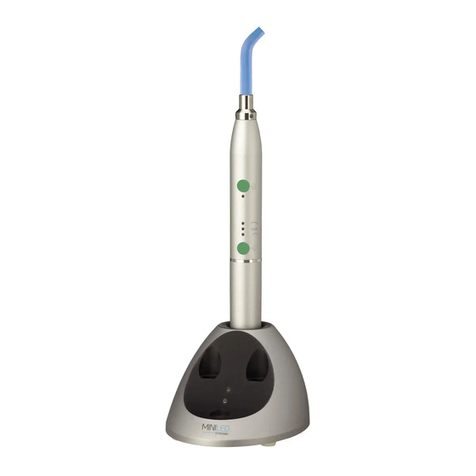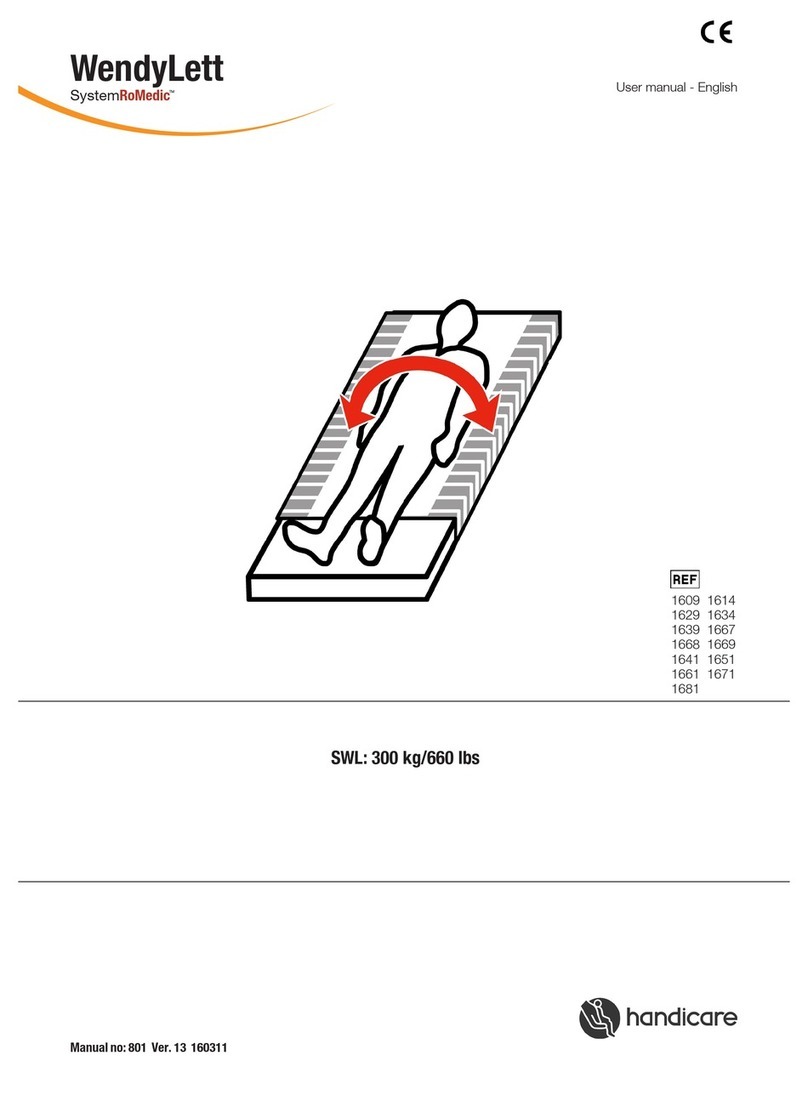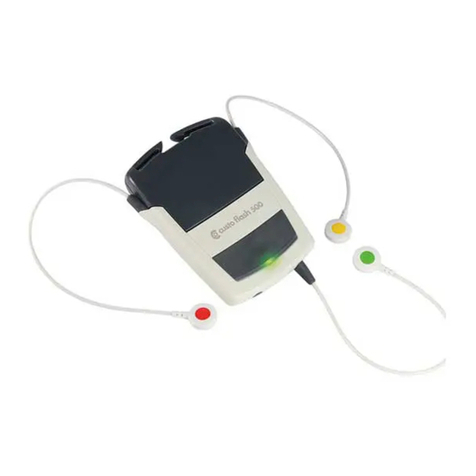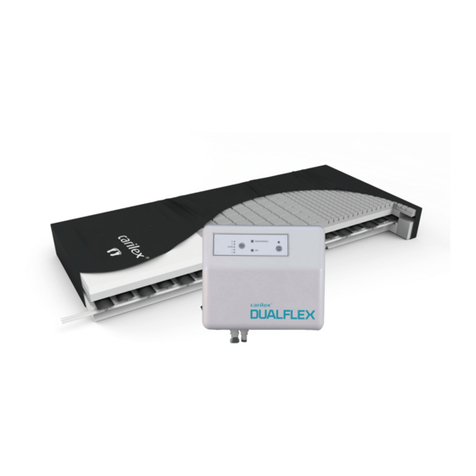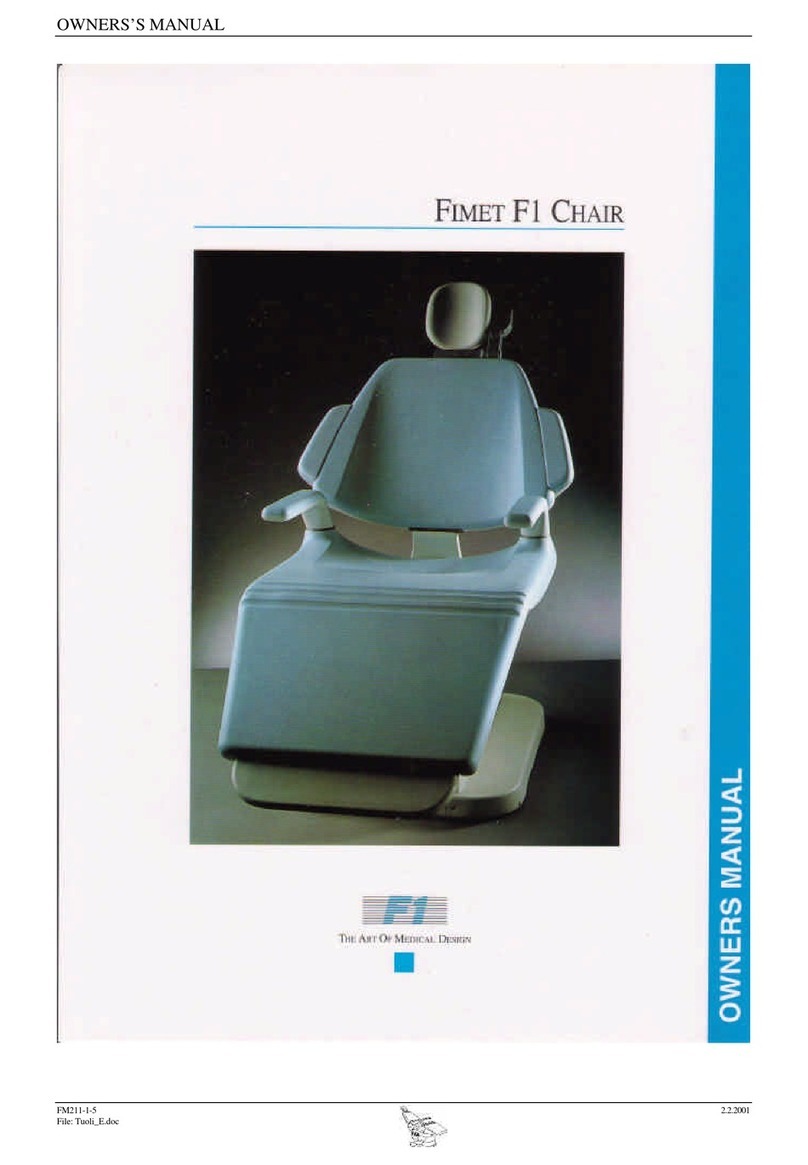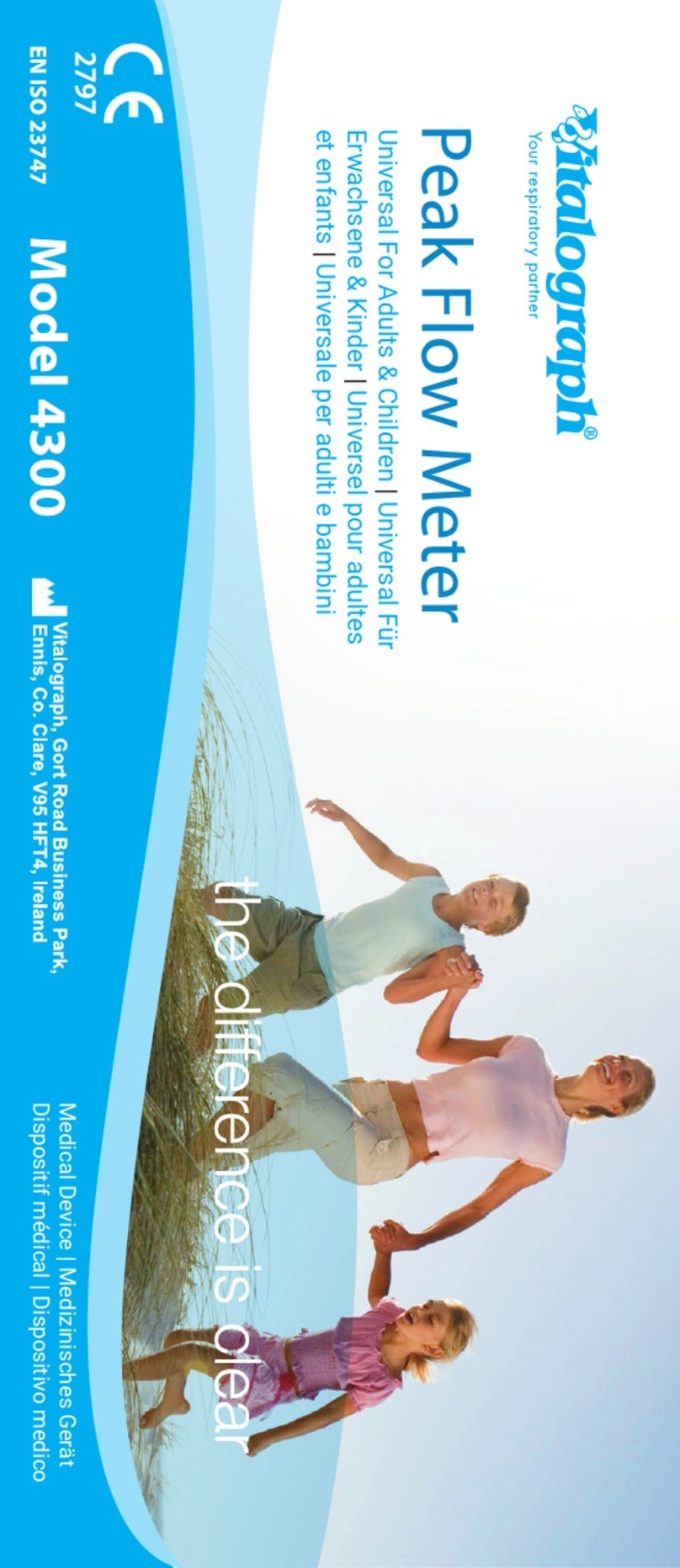InfuTronix Nimbus II Plus User manual

Nimbus™II Plus
Ambulatory Infusion Pump
Clinician Manual
This manual is not intended for patient use. InfuTronix provides a separate manual for patient use.
Read this entire manual prior to operating the Nimbus™II Plus Ambulatory Infusion Pump.

________________________________________________________________
2NimbusTM II Plus Clinician Manual –544-IFU-IT1080, Rev. B
Contents
Section 1: General Description....................................................... 4
Indications for use.................................................................................4
Symbols................................................................................................4
Warnings...............................................................................................6
Device Diagrams ..................................................................................9
Keypad Diagram.................................................................................10
LCD Screen Symbols.........................................................................11
Section 2: Setting Up the Pump ................................................... 12
Prime the Administration Set..............................................................12
Load the Cassette...............................................................................13
Section 3: Program and Operate the Pump................................. 14
Infusion Safeguards............................................................................14
Programming Parameter Labels ........................................................16
Basal Infusion Mode...........................................................................17
Demand Bolus ....................................................................................17
Auto-Bolus ..........................................................................................17
Loading Dose......................................................................................18
Maximum Volume/hour and Volume/interval limits............................18
Keypad operation................................................................................19
Power on the Pump............................................................................19
Starting a New Infusion (New Rx)......................................................19
Manual Programming .........................................................................20
Library.................................................................................................22
Retrieving and selecting the Current Rx ............................................24
Resume Infusion / New Infusion Menu ..............................................24

________________________________________________________________
NimbusTM II Plus Clinician Manual - 544-IFU-IT1080, Rev. B 3
Start the Infusion.................................................................................25
Infusion Display screen ......................................................................25
Acknowledge an Alert.........................................................................26
Titrate During the Infusion..................................................................26
Suspend/ Resume the Infusion..........................................................27
Infusion Complete...............................................................................28
Power off the Pump............................................................................28
Unload the Cassette...........................................................................28
Section 4: Battery Replacement................................................... 29
Authorized Battery..............................................................................29
Section 5: Troubleshooting........................................................... 32
Section 6: Maintenance ................................................................ 36
Storage and Transportation................................................................36
Cleaning and Disinfection...................................................................36
Recycling ............................................................................................37
Service Information.............................................................................38
Limited Warranty.................................................................................38
Section 7: Specifications............................................................... 40
Appendix A: Approved Administration Sets ................................. 42
Appendix B: Accuracy Test Results............................................. 43

________________________________________________________________
4NimbusTM II Plus Clinician Manual –544-IFU-IT1080, Rev. B
Section 1: General Description
Indications for use
The Nimbus™II Plus Ambulatory Infusion Pump is intended to deliver
medications and/or fluids to a patient under the direction or supervision of a
physician or other certified healthcare professional in clinical or nonclinical
environments, such as homes. The device is intended for subcutaneous,
percutaneous, perineural, epidural and intravenous infusion, including but not
limited to patient controlled analgesia (PCA) delivery.
Symbols
Symbol
Standard
Reference
number and
title of symbol
Description of
symbol
ISO 15223-1:2012
Medical devices -- Symbols
to be used with medical
device labels, labelling and
information to be supplied --
Part 1: General
requirements
5.4.3
Consult
instruction for
use
Indicates the need
for the user to
consult the
instructions for use.
ISO 15223-1:2012
Medical devices -- Symbols
to be used with medical
device labels, labelling and
information to be supplied --
Part 1: General
requirements
5.4.4
Caution
Indicates the need
for the user to
consult the
instructions for use
for important
cautionary
information such as
warnings and
precautions that
cannot, for a variety
of reasons, be
presented on the
medical device itself.
IEC 60417:2002 DB
Graphical symbols for use
on equipment
5333
Type BF applied
part
To identify a type BF
applied part
complying with IEC
60601-1.

________________________________________________________________
NimbusTM II Plus Clinician Manual - 544-IFU-IT1080, Rev. B 5
Symbol
Standard
Reference
number and
title of symbol
Description of
symbol
ISO 15223-1:2012
Medical devices -- Symbols
to be used with medical
device labels, labelling and
information to be supplied
-- Part 1: General
requirements
5.3.4
Keep dry
Indicates a medical
device that needs to
be protected from
moisture.
ISO 15223-1:2012
Medical devices -- Symbols
to be used with medical
device labels, labelling and
information to be supplied
-- Part 1: General
requirements
5.3.2
Keep away
from sunlight
Indicates a medical
device that needs
protection from light
sources.
ISO 15223-1:2012
Medical devices -- Symbols
to be used with medical
device labels, labelling and
information to be supplied
-- Part 1: General
requirements
5.3.7
Temperature
limit
Indicates the
temperature limits
to which the medical
device can be safely
exposed.
ISO 15223-1:2012
Medical devices -- Symbols
to be used with medical
device labels, labelling and
information to be supplied
-- Part 1: General
requirements
5.1.7
Serial number
Indicates the
manufacturer's
serial number so that
a specific
medical device can
be identified
Rx Only
N/A
Prescription
only
Federal (U.S.A) law
restricts this device
to sale by or on the
order of a physician.
ISO 7010: 2011
Graphical Symbols –Safety
Colours and Safety Signs –
Registered Safety Signs –
Part 5: Registered Safety
Signs
M002
Refer to
instruction
manual /
booklet
Indicates that failure
to follow operating
instructions could
place the PATIENT or
OPERATOR at risk.

________________________________________________________________
6NimbusTM II Plus Clinician Manual –544-IFU-IT1080, Rev. B
Warnings
A Warning ( ) alerts you to a potentially hazardous condition, safety hazard or
equipment damage.
Read the entire Clinician Manual prior to operating the NimbusTM II Plus
Ambulatory Infusion Pump. InfuTronix assumes no responsibility for
incidents that may occur if its product is not used in accordance with its
product labeling.
This Manual and the Clinician Quick Reference Guide are not intended
for patient use. These documents contain information regarding
programming and locking functions not contained in the Patient’s
Manual or Patient Quick Reference Guides.
If a patient or caregiver is to operate the NimbusTM II Plus pump without
the direct supervision of a medical professional, the patient or caregiver
should be trained by a medical professional to operate the pump. This
training should include all necessary operations of the pump. The
patient or caregiver should have the means to contact the patient’s
health care provider at all times when not under direct supervision.
As applicable, provide the patient or caregiver with instructions for
proper handling and/or disposal of the pump, the
cassette/administration set, and the pouch.
If the NimbusTM II Plus pump is used to provide medication or fluid
therapy to any patient under the age of 18, that patient should, during
therapy and while having physical access to the pump and
administration set, be under the direct supervision of an adult caregiver
trained to operate the pump.
If the mental or physical condition of a patient or caregiver could
interfere with or preclude the proper operation or safe use of the
NimbusTM II Plus pump, an alternate means of therapy should be
utilized.
The pump is not to be used for delivery of blood or cellular blood
products.
The pump is not to be used for delivery of life-sustaining medication
without a backup pump available.
Do not use the pump or cassette/administration set to administer any
infusion to the epidural space unless the medication and/or fluid
infused is indicated for epidural administration.
Do not use the pump in or near a MRI (Magnetic Resonance Imaging)
device.

________________________________________________________________
NimbusTM II Plus Clinician Manual - 544-IFU-IT1080, Rev. B 7
Warnings, continued
Do not expose the pump to X-Rays, Gamma Rays, or other Radiation.
Operating the pump near equipment that radiates high-energy radio
frequencies (electrosurgical/cauterizing equipment, etc.) may cause
false alarm conditions. If this happens, reposition the device away from
the source of interference or use an appropriate clinical alternative.
Do not operate this pump in the presence of flammable anesthetics
mixture with air, oxygen, or nitrous oxide.
Do not operate the pump at temperatures below 5°C or above 40°C.
Incorrect device handling may lead to allergen exposure and patient
allergic response.
Only use InfuTronix approved cassettes/administration sets with the
pump.
Do not use a cassette/administration set beyond its expiration date.
Each cassette/administration set is to be used with a single
medication/fluid container.
Always read and follow the instructions that accompany the fluid
container you are using.
Only use the pump and cassette/administration set with a non-vented
collapsible reservoir or syringe.
Attach the medication/fluid container to the cassette/administration set
before attaching the cassette to the pump.
Prime the cassette/administration set according to the instructions
provided in this manual prior to connecting the cassette/administration
set to the pump. Ensure that the entire fluid path is free of all air before
connecting to the patient.
Carefully follow the instructions in this document for loading and
removing the cassette/administration set. A detached or improperly
attached cassette could result in unregulated gravity infusion of
medication from the fluid container. Replace the administration set
according to the set label or by following the facility protocol.
When attaching the cassette to the pump, press and hold the cassette
latch lock button to properly make the attachment.
Attach the cassette/administration set to the pump before connecting
the administration set to a patient.
Prior to use, always verify the proper function of the display, audible,
and visual alerts during Power On Self-Test (POST).
Always verify the displayed infusion parameters (Rate, VTBI, Time)
with the prescription before starting infusion. A two-person verification
is recommended.
Do not over-program the VTBI. Program the actual amount of the fluid
in the medication/fluid container.

________________________________________________________________
8NimbusTM II Plus Clinician Manual –544-IFU-IT1080, Rev. B
Warnings, continued
Always confirm that the established infusion route matches the
intended administration route prior to the start of the infusion.
Clearly differentiate established administration routes when using the
pump with a patient that has multiple administration routes established.
Do not operate the pump outside of the environmental limits detailed in
the pump specifications.
Upon starting an infusion, the slide clamp should be opened.
Before packaging the drug/fluid bag and pump into the pouch, check
the fluid path for kinks, closed clamp or other occlusions.
Do not put excessive pressure on the pump that may cause the device,
bag or tubing to compress (i.e. leaning against pouch, sleeping on
pouch, etc.).
Do not leave the pump or cassette/administration set unattended at
home or other places where children or pets may come in contact with
the device.
Disconnect the administration set from the patient before removing the
cassette from the pump.
Always close the slide clamp before removing the cassette from the
pump.
Do not store the pump with a cassette/administration set attached.
Do not place objects over the pump that may muffle the pump.
If the pump is not functioning as expected, the pump should not be
used, and should be returned for inspection or repair.
There are no user serviceable parts inside the pump. Refer all services,
repairs, and calibrations to qualified technical personnel. Do not make
unauthorized modifications to the infusion pump.
Avoid spills on the pump. Follow the instructions specified in Section 6
of this manual for cleaning and disinfection of the pump.
To avoid mechanical or electronic damage, do not steam, autoclave, or
immerse the pump in any fluids or cleaning solutions, and do not spray
such fluids directly on the pump.
Failure to properly follow the cleaning instructions may result in an
electrical hazard, damage to the pump, and voided warranty coverage.
Do not use this device for neonates.
If the pump is dropped or hit, inspect the pump for damage.
Immediately stop using the pump if it is physically damaged or not
functioning properly. Contact distributor to return the pump.
Avoid using and/or storing the pump where it may come in contact with
excessive lint, dust, direct sunlight, heat and moisture.

________________________________________________________________
NimbusTM II Plus Clinician Manual - 544-IFU-IT1080, Rev. B 9
Device Diagrams
Front View
The Liquid Crystal Display (LCD) and keypad are backlit. The backlight will
disappear after 30 seconds of no response.
Rear View
LCD
Keypad
LED Indicator
Cassette
Cassette Latch
Cassette Latch Lock (Black)
Battery Compartment
Product Labels

________________________________________________________________
10 NimbusTM II Plus Clinician Manual –544-IFU-IT1080, Rev. B
Keypad Diagram
Key
Name
Description
ON/OFF
Hold for 3 seconds to power on or off the device.
RUN/STOP
Press to start or resume the infusion.
Hold for 3 seconds to pause the infusion.
ENTER
Press to confirm an input value or to advance to
the next screen.
DOWN
Press to decrease the value of a parameter or
move the cursor downward.
UP
Press to increase the value of a parameter or
move the cursor upward.
INFO
In Programming mode, press to return to the
previous screen.
In Run mode, press to access the Infusion History
menu to view Shift Totals, review the Rx, and/or
Titrate protocol values.

________________________________________________________________
NimbusTM II Plus Clinician Manual - 544-IFU-IT1080, Rev. B 11
Key
Name
Description
BOLUS
Press and release the BOLUS key to request a
Demand Bolus delivery.
Hold the BOLUS key for 3 seconds to cancel a
Delay Start infusion.
LCD Screen Symbols
Item
Name
Symbol
Description
1
Therapy Mode
The fluid bag symbol displays when the
pump is infusing.
2
Configuration
Mode
Displays when the pump is in the
configuration mode.
3
Battery Level
Indicator
This symbol indicates a full battery
level.
This symbol indicates a medium battery
level.
This symbol indicates a low battery
level.
This symbol indicates an empty battery
level.
4
Alert
This symbol will display if an alert
condition is present.
5
Prescription
mode
The pump is in Prescription mode.
6
Pause
The infusion is paused.

________________________________________________________________
12 NimbusTM II Plus Clinician Manual –544-IFU-IT1080, Rev. B
Press Anti-free-flow Clamp (green)
Slide Clamp Spacer (blue)
Section 2: Setting Up the Pump
Prime the Administration Set
Prime the cassette/administration set according to the following instructions
prior to connecting the cassette to the pump. Attach the primed cassette to the
NimbusTM II Plus pump before connecting to the patient.
Warning:The Nimbus Administration set is sterile.
Do not use if the package has been opened or
damaged.
Warning: Only a non-vented collapsible medication
reservoir can be used.
Warning: Do not use excessive pressure when
squeezing the fluid bag to prime the cassette.
Caution: Use aseptic technique.
1. Prepare the drug/fluid bag.
2. Remove the cassette/administration set
from the package. Close the slide clamp. When using a bag spike
cassette, remove the spike cap. Fully insert the spike into the drug/fluid
bag. When using a cassette with a proximal luer connector, remove the
female luer lock cap. Connect the female luer lock to the medication
reservoir.
3. Lay the cassette on a clean surface for priming.
4. Open the slide clamp.
5. Hold the medication/fluid bag in hand with the spike port facing up.
6. Gently squeeze the bag in order to purge air from the bag and prime the
set. Continue squeezing the bag until fluid fills the entire length of the
tubing and all the air has been removed from the system. The NimbusTM
II Plus Ambulatory Infusion Pump does not have an electronic air
sensor, however does use an in-line air-eliminating filter to evacuate air
from the infusion line. Close the slide clamp after priming.
7. Engage the anti-free flow clamp on the cassette by pressing the green
clamp head and sliding out the blue anti-free flow clamp spacer
Caution: The blue anti-free flow clamp spacer is a small object and may cause
choking if swallowed. Properly dispose of the spacer and any other unneeded
small parts. Keep away from children.

________________________________________________________________
NimbusTM II Plus Clinician Manual - 544-IFU-IT1080, Rev. B 13
Load the Cassette
1. Engage the cassette “fingers” with the pump hinge.
2. Press the cassette latch lock down and firmly push the cassette
towards the pump.
3. Release the cassette latch lock.
4. Confirm that the three hooks on the cassette latch are fully engaged
with the cassette.

________________________________________________________________
14 NimbusTM II Plus Clinician Manual –544-IFU-IT1080, Rev. B
Section 3: Program and Operate the Pump
Note: Any values in the screenshots provided are for general guidance only
and may not match specific configurations.
Infusion Safeguards
Before entering a prescription on the NimbusTM II Plus pump, the user should
be aware of the internal and external safety measures designed into the system
to control the infusion delivery as protection against under or over infusion of
local anesthetic.
Feature
Description
Integrated free-
flow protection
Protects against gravity infusion in the event the cassette is
removed or displaced from the pump.
Auto-locking
keypad
Automatically safeguards the prescription against unauthorized
changes.
Default Protocol
Library
Pre-validated therapy values stored on the pump for rapid
confirmation then automatically loaded to the active prescription
minimizing keystroke entries and risk of error.
Custom Protocol
Library
A user can request custom therapy modes and values are stored
on the pump tailored to meet clinician and facility specifications.
Drug Name &
Concentration
display
Enhances clinician mindfulness to the brand, properties and
strength of medication infused in the Rx.
Infusion History
display
Provides clinical recognition to the therapy history to review and
confirm for patient appropriateness.
Shift Totals Menu
Enables confirmation the Rx matches the med order and
document infusion history for the EMR.
Basal Rate Min /
Max
A protocol value cannot exceed the maximum safe limit
programmed into the library or global guard.
Demand Bolus
Min / Max
A protocol value cannot exceed the maximum safe limit
programmed into the library or global guard.
Demand Bolus
Lockout
Restricts any subsequent attempts for Boluses until a user-defined
safe time interval has elapsed.
Auto-Bolus Min /
Max
A protocol value cannot exceed the maximum safe limit
programmed into the library or global guard
Auto-Bolus
Interval
A user-defined safe interval of time that must elapse prior to the
next scheduled intermittent bolus dose of medication is allowed.

________________________________________________________________
NimbusTM II Plus Clinician Manual - 544-IFU-IT1080, Rev. B 15
Feature
Description
Max Vol/hour
Safe limits programmed into the library to set the maximum
volume of medicine delivered per hour and per interval
through any combination of basal rate, Demand Bolus and
Auto-Bolus infusion.
Max Vol/Interval
Delayed Infusion Start
A user-defined standby timer placing the pump in hold mode
while the surgical block is in effect restricting the volume of
local anesthetic delivery over the top of the primary block
dose.
Protection against under-infusion or non-delivery of medication is also a
deliberate goal to prevent an undesirable outcome. When a condition that
could interrupt the infusion is detected, the NimbusTM II Plus Ambulatory
Infusion Pump will alert with a visual and audio signal to indicate the presence
of the condition. Depending on the condition, the infusion may resume
automatically when the event is resolved without requiring user intervention.
Alert
Messages
Indication
Upstream
Occlusion
Decreased pressure is detected in the supply line between the pump
and IV bag.
Note: The infusion will be stopped automatically and will resume
immediately when the condition is resolved.
Downstream
Occlusion
Increased pressure is sensed in the line between the pump and the
patient.
Note: The infusion will be stopped automatically and will resume
immediately when the condition is resolved.
Pump
Unattended
The pump is standing by and not infusing for more than 10 minutes.
Max Vol
Reached,
Pump
Standby
The pump has reached a maximum volume per hour or interval limit.
Note: The infusion delivery will be paused automatically and will resume
immediately when the new hour or interval timeframe is reached. The
remaining volume of any active bolus or intermittent dose will be
scrapped.

________________________________________________________________
16 NimbusTM II Plus Clinician Manual –544-IFU-IT1080, Rev. B
Alert
Messages
Indication
Battery
Depleted
The infusion will continue for 30 minutes before the device powers off.
System or
Firmware
Error
The pumping mechanism may not work properly.
Note: The infusion will be stopped automatically.
Refer to Section 5: Troubleshooting for a complete list of alerts, descriptions
and troubleshooting steps.
Programming Parameter Labels
A prescription can be defined using some or all of the parameters displayed in
the table below. Parameter limits programmed into the protocol Library can be
more restrictive than system limits allowing the protocol to be customized to a
specific therapy or patient type.
Parameter Name
Parameter Label
Basal Rate (PCA)
Rate
Volume to be Infused
VTBI
Auto-Bolus Volume
AB Vol
Auto-Bolus Interval
Q Int
Demand Bolus Volume
DB Vol
Demand Bolus Lockout
DB Lck
Maximum Volume per Hour limit
Max/h
Maximum Volume per Interval limit
Max/Int
Loading Dose
LDS
Delay Start Timer
Delay
Keep Vein Open (KVO) Rate
KVO
Intermittent Dose Volume
Dose Vol
Intermittent Dose Rate
Rate
Intermittent Interval
Q Int
Concentration
Conc
Dose (Weight Based)
Dose
Patient (Weight Based)
Wght
Infusion Runtime
Time

________________________________________________________________
NimbusTM II Plus Clinician Manual - 544-IFU-IT1080, Rev. B 17
Basal Infusion Mode
Basal Infusion delivery infuses medication at a constant, programmed rate.
Demand Bolus
Demand Bolus delivery is a feature that allows a continuous Basal infusion
supplemented with patient-controlled demand boluses. The user may define a
demand bolus volume (DB Vol), Demand Bolus lockout time (DB LCK) and
maximum volume per hour value (Max/h) to control the overall volume of
infusion.
Auto-Bolus
Auto-Bolus delivery is a feature that allows the user to schedule intermittent
volume doses of anesthetic to be delivered at regular, repeated intervals. At
the discretion of the user, Basal Infusion and/or Demand Bolus delivery modes
can be programmed to supplement the scheduled Auto-Bolus doses.
In the Auto-Bolus mode, a user may define a continuous Basal Flow, Auto-
Bolus volume (AB Vol), interval (Q Int), maximum volume per hour value
(Max/h) and maximum volume per interval value (Max/Int) to control the overall
volume of infusion.
Upon starting the infusion, the pump will infuse the Auto-Bolus dose at the
beginning of the therapy followed by the Auto-Bolus interval (Q Int).

________________________________________________________________
18 NimbusTM II Plus Clinician Manual –544-IFU-IT1080, Rev. B
Loading Dose
When Auto-Bolus mode is selected, the user can define a Loading Dose to be
delivered at the beginning of the prescription as the primary dose immediately
followed by the Bolus Interval period. When the Bolus Interval time has
expired, the next scheduled Auto-Bolus dose will be delivered. At the users
discretion a Basal Flow can be set to supplement the therapy during the interval
periods.
Maximum Volume/hour and Volume/interval limits
To safeguard the volume of medication delivered to the patient, the NimbusTM II
Plus Ambulatory Infusion Pump enables the user to define volume limits
allowed per hour and/or per interval. The NimbusTM II Plus Ambulatory Infusion
Pump accumulates the volume of medication infused using any combination of
delivery modes and stops the infusion when a maximum limit is reached.
•A message will display on the screen signaling a maximum volume limit
is reached.
•The pump will remain in standby mode until the next hour or next
interval is reached.
•The undelivered volume of any active Demand Bolus, Auto-Bolus or
Basal infusion will be discarded.
•The infusion will automatically resume when the next hour or next
interval is started and the accumulators will restart.

________________________________________________________________
NimbusTM II Plus Clinician Manual - 544-IFU-IT1080, Rev. B 19
Keypad operation
Refer to the Keypad Diagram on page 10 for a review of keypad functions to
enter a prescription and navigate through the menus.
Power on the Pump
Hold the ON/OFF key for 3 seconds to turn on the pump. The pump starts
a Power-On-Self-Test (POST). During the POST:
•The LCD displays the screen as shown to the
right
•The LED flashes a red, green, yellow, off, and
then red light.
•An audio tone of 1 long beep, followed by 4
short beeps.
•The software version number and the serial number of the pump are
displayed.
•The protocol library information is displayed at the bottom of the
screen, with the name and the version number of the library. The figure
shows the default library is loaded, where “Lib PLUSNA” stands for the
sample library name and “v#.#.#” stands for software version number.
If an error is detected during POST, the screen displays a corresponding alert
message. Refer to Section 5: Troubleshooting for an explanation of the alert
message and the correct user response.
Upon a successful completion of POST, the screen displays the main menu
and the LED turns to orange. The user may then program a new manual
prescription or choose a default prescription from the library.
Caution: Please check the battery level prior to initial usage. Consider
replacing the battery with a new one if needed.
Starting a New Infusion (New Rx)
After the pump is powered ON, the LCD displays one
of the screen menus shown to the right.
•When the pump is powered on for the first
time, the screen will display only “New Rx” in
the menu.

________________________________________________________________
20 NimbusTM II Plus Clinician Manual –544-IFU-IT1080, Rev. B
•If the pump has previously been powered on
and a prescription entered, the screen will
display “Current Rx” and “New Rx” in the
menu.
Note: After a prescription is initiated on the Nimbus II
Plus pump it will be saved as the Current Rx.
Note: If an infusion is started and the pump is powered off, the pump will
remember the parameters where it left off when the infusion was stopped.
To program a new prescription:
1. Highlight New Rx then press the ENTER key
.
2. If Clinician Code Lock is enabled, enter values
for a valid three-digit Clinician Code to unlock the Rx.
3. Press the ENTER key to continue.
Note: The clinician codes can be disabled or
customized upon request.
After entering a clinician code, the pump advances to the programming screen.
The menu provides the option to choose to a category and then a protocol or
enter manual mode if enabled.
Manual Programming
If manual programming is enabled, select manual
programming by:
1. Use the UP key and DOWN key to
move the highlight to move down to Manual.
2. Press the ENTER key .
In the manual program, the user can select from five modes and input the
parameter values.
Table of contents
Popular Medical Equipment manuals by other brands

Boston Scientific
Boston Scientific Precision SC-5312 quick start guide
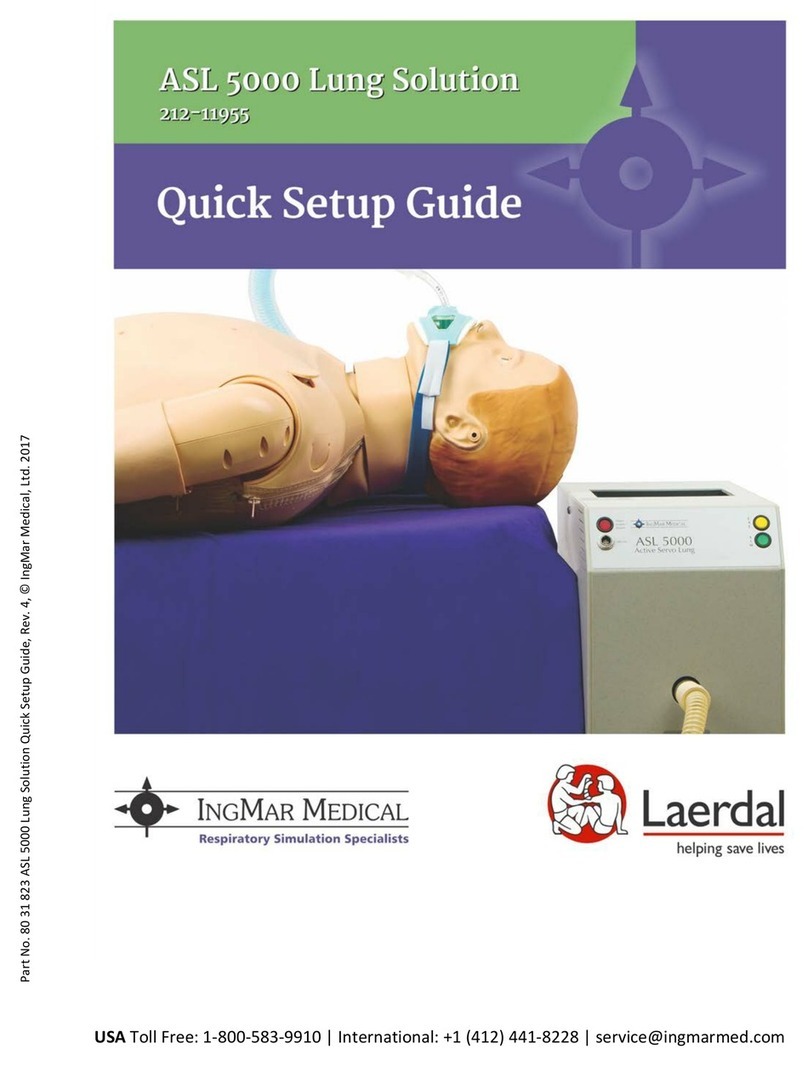
IngMar Medical
IngMar Medical ASL 5000 Quick setup guide
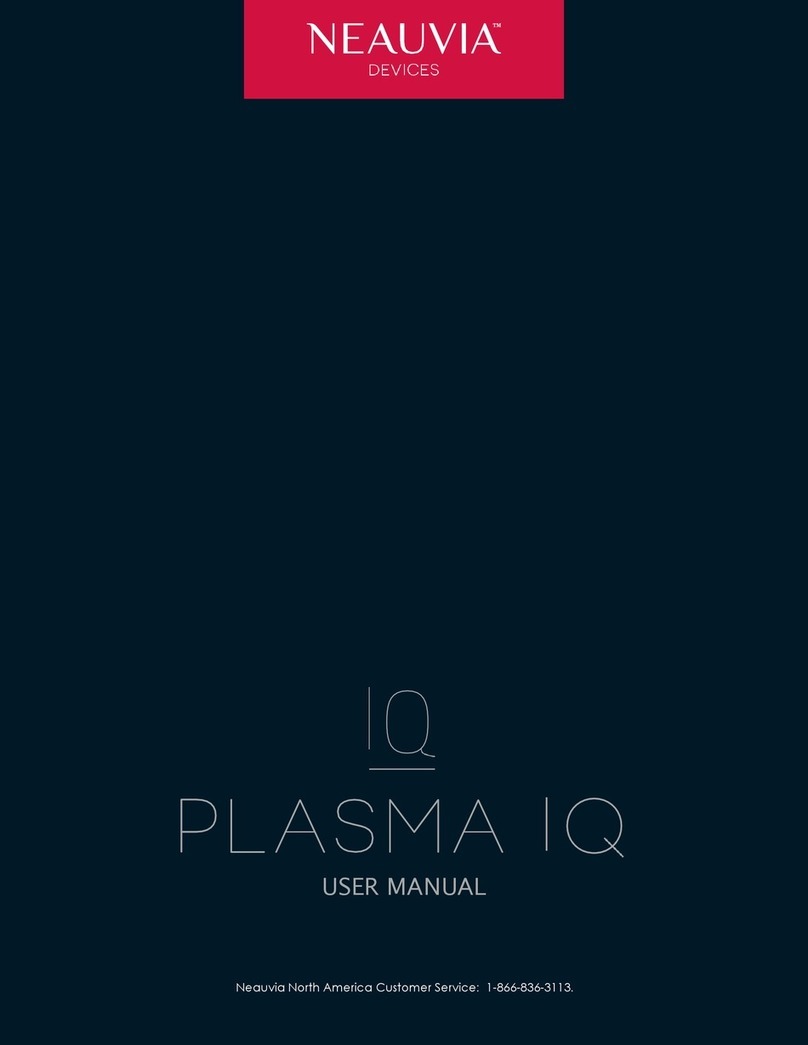
Neauvia
Neauvia PLASMA IQ user manual
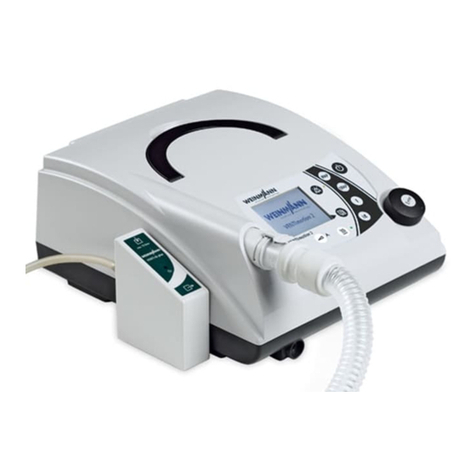
Weinmann
Weinmann VENTImotion Series Description of Unit and Operating Instructions for Patients

Avita
Avita BPM13B instruction manual
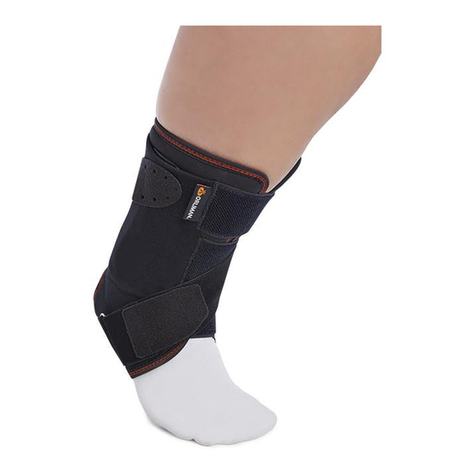
Orliman
Orliman ONE PLUS OPL490 INSTRUCTIONS FOR USE AND PRESERVATION
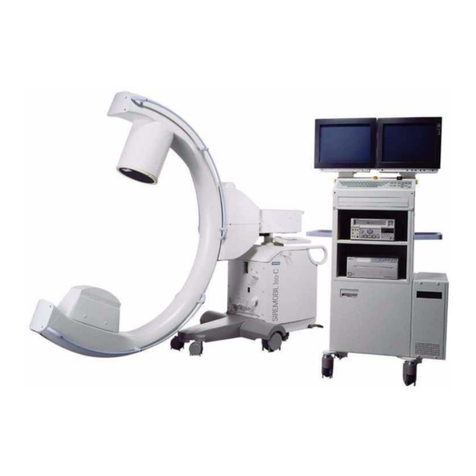
Siemens
Siemens SIREMOBIL Iso-C 3D installation instructions

Direct Supply
Direct Supply Direct Choice DSDC2CPD owner's manual
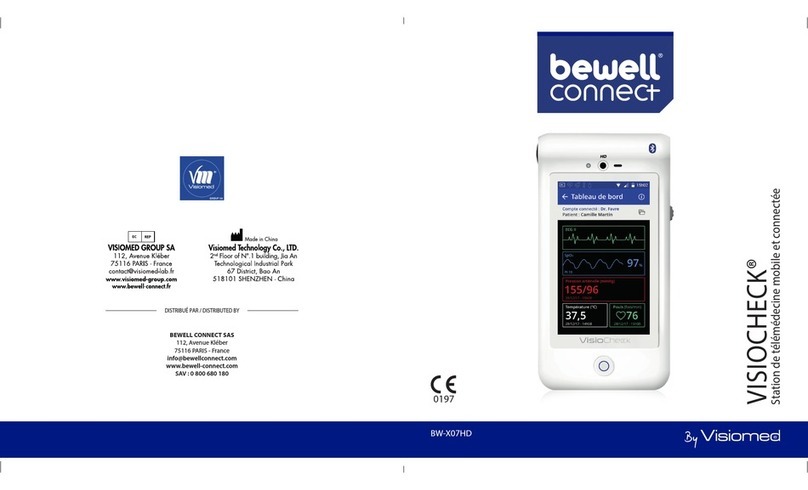
VISIOMED
VISIOMED Visiocheck BW-X07HD user manual

Nasco Healthcare
Nasco Healthcare 149-1350 instruction manual
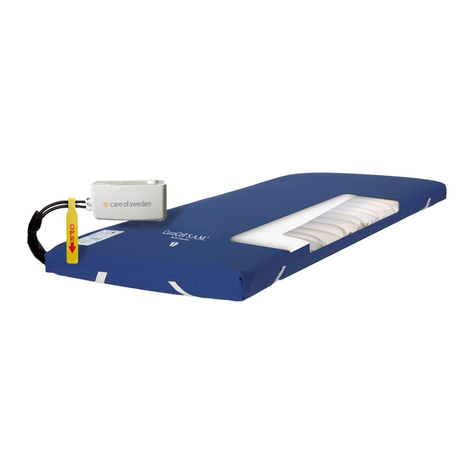
Care of Sweden
Care of Sweden CuroCell S.A.M. PRO Instructions for use
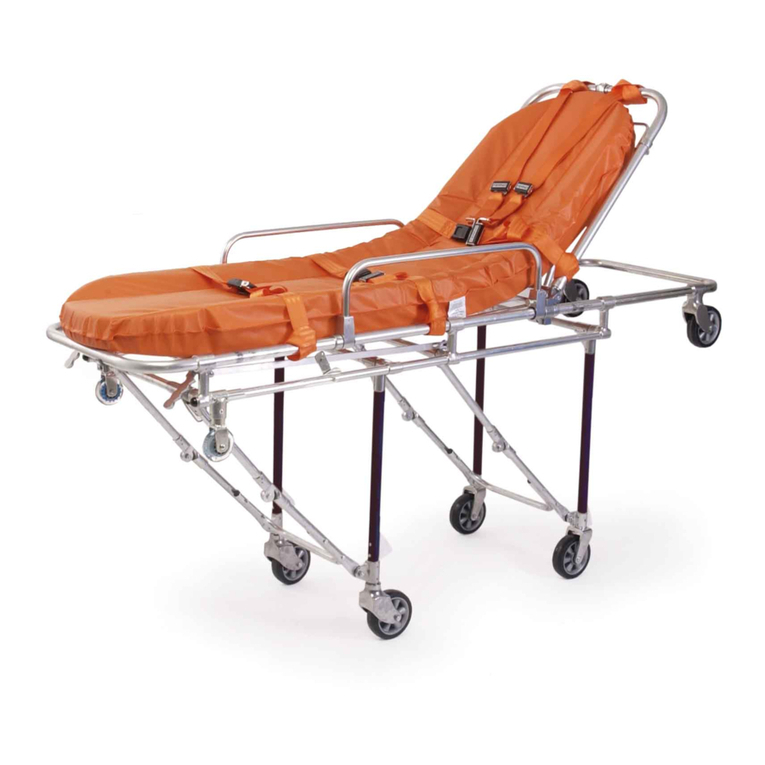
Ferno
Ferno Mobile Transporter 35A Series user manual
